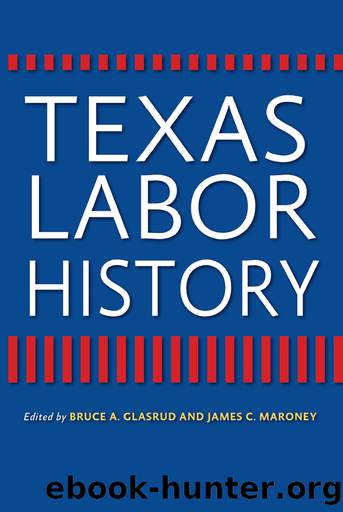Texas Labor History by Glasrud Bruce A.;Maroney James C.;

Author:Glasrud, Bruce A.;Maroney, James C.;
Language: eng
Format: epub
Publisher: Texas A&M University Press
Published: 2013-08-15T00:00:00+00:00
11
Unionizing the Trinity Portland Cement Company in Dallas, Texas, 1934â1939
GREGG ANDREWS
In 1934â35 Pres. Franklin D. Rooseveltâs administration confronted a direct challenge to Section 7(a) of the National Industrial Recovery Act (NIRA) in Dallas, Texas. A local panel of the National Labor Relations Boardâestablished by the president through power given him by a congressional resolution in June 1934âruled that the Trinity Portland Cement Company had to recognize the overwhelming desire of workers at the companyâs plant in Dallas to name Portland Cement Workers Union No. 19310 as their exclusive bargaining agent. Portland Cement Workers Union No. 19310 was affiliated with the Texas State Federation of Labor (TSFL) and the American Federation of Labor (AFL). On December 10, 1934, however, the company notified the board that it refused to comply with the ruling.1
Although Trinityâs workers had voted in favor of the union by a nearly unanimous margin of 150 to 2, company officials held out in defiance of the NIRAâs labor provisions, hoping to retain their company union and reaffirm exclusive control over labor policies. Until January 1939, Trinityâs workers battled an array of antiunion measures in an attempt to force the company to recognize their union and sign a collective bargaining agreement. After a tenacious campaign to assert their rights under the New Deal, the workers achieved a victory whose ramifications extended beyond the Dallas plant. Trinity signed joint labor agreements at all three of its Texas plantsâthe first such labor agreements signed with a cement corporation in the United States.
Trinityâs first plantâlocated near the west fork of the Trinity River on a five-hundred-acre bed of limestone and shale reserves in Eagle Ford, a small community on the western edge of Dallas Countyâbegan producing cement in 1909. The company built a plant in Fort Worth in 1924 and another in Houston in 1926.2 The campaign to organize workers at Trinityâs Eagle Ford plant also was tied to unionization efforts at the Lone Star Cement Company in the nearby community of Cement City. In fact, Eagle Ford was so close that Dallas residents at the time commonly referred to both communities as Cement City.3
The Eagle Ford and Cement City mills were the first cement plants in Dallas, the stateâs largest city in 1910. Clustered together, the two plants converted West Dallas into a focal point of cement manufacturing to service the growing demands of an increasingly urbanized area. The Trinity plant took advantage of good rail facilities via the Texas and Pacific Railway and the Texas Northern Railroad to ship barrels and jute bags of cement. The cement was used to pave Dallas-area streets and sidewalks, build viaducts and bridges, encase artesian wells drilled by area farmers for irrigation purposes, build highways, and facilitate other construction and oil drilling projects in Texas, New Mexico, Louisiana, Arkansas, and Oklahoma.4
Trinity had no difficulty attracting a cheap labor force. Many of the plantâs initial unskilled production workers were Mexican immigrants uprooted by the Mexican Revolution and drawn by the lure of industrial jobs to Dallas.
Download
This site does not store any files on its server. We only index and link to content provided by other sites. Please contact the content providers to delete copyright contents if any and email us, we'll remove relevant links or contents immediately.
A Cultural History of Work in the Age of Empire by Victoria E. Thompson (ed.)(247)
The Evidence of Things Not Seen by James Baldwin(246)
Warrior Queens & Quiet Revolutionaries by Kate Mosse(245)
Executive Order No. 9066: The Terrible Injustice Of 1942 by Sollace Freeman(232)
The Explorers by Amanda Bellows(221)
A Wider Type of Freedom: How Struggles for Racial Justice Liberate Everyone by Daniel Martinez HoSang(198)
Respectability and Reform by Tara M. McCarthy(185)
Liberty's Dawn: A People's History of the Industrial Revolution by Emma Griffin(173)
The Grey Eagles of Chippewa Falls by John E. Kinville(165)
Rethinking White Societies in Southern Africa by Duncan Money(164)
Letters From London by Julian Barnes(162)
The Crosswinds of Freedom by James MacGregor Burns(160)
A Troublemaker May Surprise (The Troublemaker Series Book 2) by Genta Sebastian(149)
Evolution of Slavery Through the Ages: A Comprehensive World History of Slavery by PRESS VERITY(144)
A Teacher's Guide to Ladies of Liberty by Cokie Roberts Amy Jurskis(136)
Continental Strangers by Gemunden Gerd;(135)
The Slave Ship, Memory and the Origin of Modernity by Martyn Hudson(133)
Hunger Dark Pen by Dark Pen(125)
Beware the Masher by Kerry Segrave(124)
